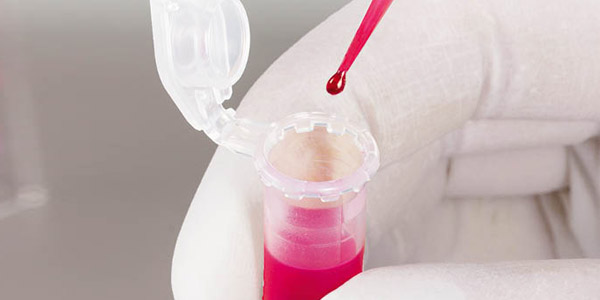
Improved recovery – more precise analysis
Shaking the pipette, vigorous pipetting of the sample, constantly removing and replacing the pipette tip because there is a single drop stuck to the inner wall of the tip.
Irregular findings, frustration caused by inconsistent results, trying in vain at the end of the week to reproduce the great result from the start of the week, despite carrying out all test series in the same way?
If this happens in your lab, you should take a look at our tips on low retention pipette tips.
What does ‘low retention’ mean?
The term ‘retention’ comes from the Latin word ‘retentio’, meaning ‘to hold back’. ‘Low retention pipette tips’ are therefore pipette tips which are characterized by their quality of not ‘holding back’, or retaining fluid.
How is this effect achieved?
Like all Sarstedt pipette tips, the low retention versions are also produced using high-tech, sophisticated injection molding tools. A special process is used to give the tips their low retention property by producing an even, flat, extremely hydrophobic surface. This hydrophobic surface effect, which causes fluid to roll off, is also known as the ‘lotus effect’.
How does this effect impact the pipetting process?
The hydrophobicity of the tip’s surface means it easily repels liquid. This creates a weak bond between the liquid and the plastic and enables the liquid to be dispensed without pulling, ensuring it does not break down into smaller droplets. When pipetting certain fluids, a thin residual film can form in a standard pipette tip. With low retention pipettes tips, this does not occur and the sample can be dispensed in full. This optimized dispensing and low level of interaction mean that valuable samples or reagents are no longer held within the tip and ultimately lost.
For which applications should low retention pipette tips be used?
In many routine applications, reagents with low surface tension such as detergents and protein buffers are used that are difficult to pipette precisely using standard tips. Fluids with high viscosity such as glycerine or highly concentrated protein or DNA solutions also frequently adhere to the tip surface. For very expensive or valuable reagents, where the loss of just a few microliters can incur huge costs, low retention tips can reduce expenditure.
For all pipetting applications where the loss of substances can influence the results to such an extent that it may no longer be possible to reproduce them, it is especially important to have particularly good run-off properties. This includes applications such as PCR or real-time PCR, protein analysis or SDS-PAGEs, general nucleic acid analysis, and blood or blood component analysis.
All Sarstedt pipette tips are checked for conformity with the most common pipette types as per ISO 8655-2 and nine different tip volumes for sample quantities of 0.1 µl and higher, ensuring maximum precision and pipetting reliability.
Conclusion:
Low retention pipette tips can increase pipetting precision and accuracy, particularly for challenging fluids and in applications where extremely low volumes are used. Use of the pipettes helps to lower costs by reducing material and sample loss, and saves time by producing precise and reproducible results.

